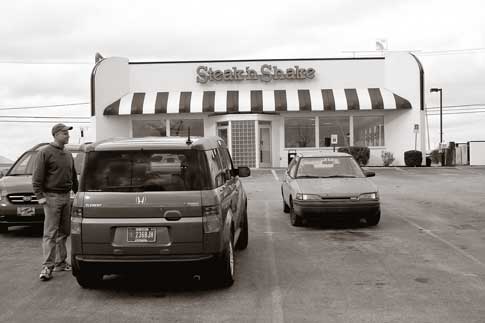Woodworking in America: Country and Gospel –

The waitress rushed up to me at the cash register with a desperate look in her eye. In defense, I held out a $6 tip, but she ignored it and fixed me in her gaze.
“Will you sign a placemat? Or a napkin?” she asked. “Do you have something you could sign?”
I shook my head and started walking to the exit.
“Sign anything,” she said. “The cooks will be so disappointed if you don’t.”
This was the final and odd scene of my four-day odyssey at the Woodworking in America show in Berea, Ky., where 350 hand-tool woodworkers got together during Nov. 14-16, to talk about tools, techniques and history.
The show itself was great fun, and I’ll be posting lots of photos and stories on my blog at Woodworking Magazine (one of the organizers of the show). But for the readers of the Lost Art Press blog, I saved this particular tale. It begins about an hour before getting rushed by the waitress.
After four days on my feet and 12 hours (total) of sleep during that period, I packed up our rented Ryder with all the workbenches, grinders and clamps we’d brought to the Woodworking in America show. Senior Editor Glen Huey climbed into the passenger seat of the truck and we drove north to get some lunch with some of the other magazine editors and John Hoffman, the other half of Lost Art Press.
We met at the Richmond, Ky., Steak ‘n Shake, and our party of five snagged a window seat and started looking at the menus.
Our waitress took our drink order and when she returned, she asked: “Are you guys the Oakridge Boys?”
To which Hoffman immediately answers: “Yes.”
I start laughing and tell her that no, we’re not the country/gospel quartet. But she is undaunted.
“The cooks up there in the red ties say you are the Oakridge Boys,” she said, pointing to the rear corner of the store. I look back to see two young guys with enormous smiles on their faces looking right at me.
I point to Associate Editor Drew DePenning at the end of the table.
“He’s 23,” I explain. “He would have been a fetus when the Oakridge Boys were popular.”
She gives me a quizzical look but takes our food order. Glen Huey is chuckling so hard he’s having trouble ordering. Senior Editor Robert Lang is his typical placid and inscrutable self.
After the waitress walks away, I start singing the base vocal to “Elvira” and try to get Bob to join in. He smiles, but he won’t take the bait.
We eat. And as we try to leave, I’m ambushed by the waitress, who insists that I’m the band’s manager. “Don’t you have some posters or CDs you could sign for us?” She chases us to the door.
We all scurry to our cars. I fetch my laptop from Hoffman’s Honda and head back to the Ryder truck.
“Crap!” Hoffman says. “I locked my keys in my car.”
Hoffman calls a locksmith, who promises to be there in 10 minutes. We stand there for a minute and realize it is too cold to wait outside.
“I guess you gotta go back into the Steak ‘n Shake,” I said.
“Oh no,” Hoffman said, shaking his head.
But then he turns and heads back into the arms of fame.
— Christopher Schwarz
P.S. After I got home, I looked up a photo of the Oakridge boys and busted out laughing. I can see it: John Hoffman is Joe Bonsall. Glen Huey is Duane Allen. Robert Lang is a better-coiffed William Lee Golden. And I’m Richard Sterban. And Drew? Just another 23-year-old gospel/country fetus, I guess.





